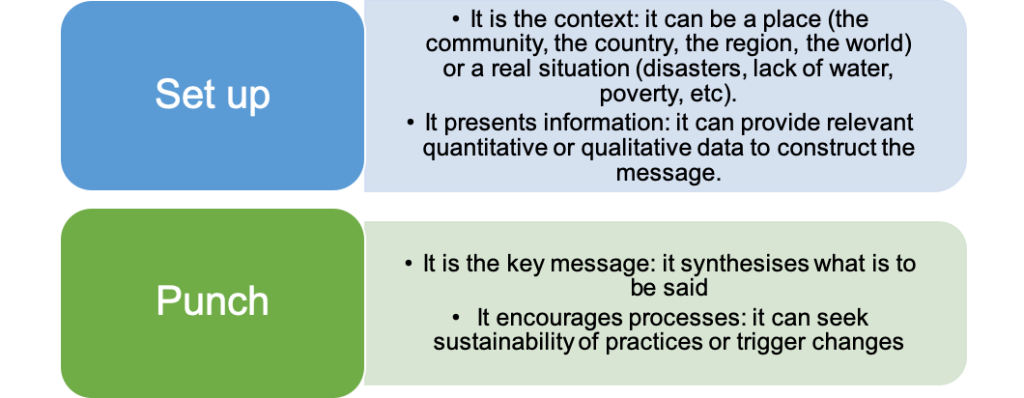Dialogue is not always easy. Factors such as gender differences, language, particular interests, emotions, etc., can cause a message to be interpreted in different ways, creating a scenario of potential controversy and disinterest in participation. However, there are techniques that can help to reduce this risk.
3.1 Techniques to facilitate dialogue
One of the most recurrent mistakes in actions to foster engagement and trust is not preparing the dialogue, i.e. not designing communication messages with clear information.
Effective communication at the community level requires pre-established messages to convey information, engage the population and guide water sector workers, especially when they are in the field or are about to launch communication campaigns.
There are different techniques for building key messages and fostering effective communication at the community level. Each always has two components: set up and punch.

| Table 3. Examples of set up and punch | ||
|
Every year we are affected by hurricanes and storms, often leaving us without drinking water. Be sure to participate in preparedness drills. |
Set up |
Every year we are affected by hurricanes and storms, often leaving us without drinking water. |
|
Punch |
Be sure to participate in preparedness drills. |
|
|
Integrated water resources management is participatory and open to the whole community, but there is little involvement of the population. Get involved and get informed about water actions. |
Set up |
Integrated water resources management is participatory and open to the whole community, but there is little involvement of the population. |
|
Punch |
Get involved and get informed about water actions. |
|
There are different techniques for constructing effective messages. The most commonly used are the one liner, the rule of three, the list, the comparison, the metaphor and the question. Each can be used according to the need of the organisation.
| Technique | Definition | Example |
|---|---|---|
| One liner | It consists of building a message from a sep up and a single punch. | Women and men have equal rights and opportunities but there is still sexism in the locality. Let’s make a change. |
| The rule of three | It consists of using one set up and three punches, with the aim of achieving a greater impact and addressing related topics. | Water is an invaluable and finite resource. Take care of its quality and quantity, promote good practices and spread them in your community and beyond. |
| The list | It consists of presenting a set up and several punches as a list. | Disputes over water use can always be solved. Don’t forget to always engage in dialogue, use real data, participate in meetings and request information from the authorities. |
| The comparison | It consists of contrasting situations, realities, problems, to compare desired/future scenarios with current/undesired ones. | With integrated water resources management, we can participate and be involved in water management. Without integrated water resources management, we cannot participate as we want to. |
| The metaphor | It consists of having a set up and a punch where the set up establishes an association between two concepts that apparently have no connection between them. | Water use involves the community as a whole. If we do not participate, our inaction can have costs. |
| The question | It consists of posing the set up as a question and the punch as an answer. | Can communities contribute to water management? Yes, through their local knowledge. |
